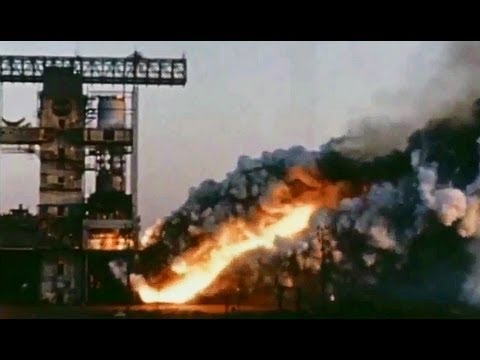more at
“The arrival of the E-1 Engine at NASA Marshall Space Flight Center in 1963.” Silent. The 1963 date in NASA’s description date might be incorrect. The E-1 program was cancelled in 1959, and sources indicate that the engine was tested in 1956.
Public domain film from NASA, slightly cropped to remove uneven edges, with the aspect ratio corrected, and mild video noise reduction applied.
Rocketdyne’s E-1 was a liquid propellant rocket engine originally built as a backup design for the Titan I missile. While it was being developed, Heinz-Hermann Koelle at the Army Ballistic Missile Agency (ABMA) selected it as the primary engine for the rocket that would emerge as the Saturn I. In the end [it was] decided to use the lower-thrust H-1… The E-1 project was cancelled in 1959, but Rocketdyne’s success with the design gave NASA confidence in Rocketdyne’s ability to deliver the much larger F-1, which powered the Saturn V to the Moon…
History
Genesis
In July 1954 the Air Force Scientific Advisory Board’s ICBM working group advised the Western Development Division (WDD) on their doubts about the Atlas missile that was then under development… The group suggested that a second ICBM project be started…
SAC’s concerns were taken to heart within the Air Force, and they directed Ramo-Wooldridge to study the issue… Ramo suggested that the Air Force begin development of a new missile that used a conventional airframe in place of the Atlas’s “balloon tanks”, and replaced the “stage and a half” layout with a two-stage design.
Titan
…a contract was awarded to Martin for what emerged as the Titan. Aerojet General was selected to build the engines… WDD also selected North American Aviation’s Rocketdyne Division to develop a backup engine.
…Starting with the basic layout from their successful MB-3/S-3 (known to the Air Force as the LR-79) from the Thor and Jupiter missiles, Rocketdyne developed the E-1 by expanding its size and tuning the engine bell for operation at lower altitudes. At higher altitudes the upper stage would be firing.
Development of the E-1 was rapid and prototypes were sent to the Santa Susana Field Laboratory later in 1955. However, development of a stable fuel injector proved difficult, and took 18 months to fully solve. Over a series of months the thrust was increased until it developed over 379,837 lbf (1,689 kN) at sea level. A complete booster stage equipped with the E-1 was fired on 10 January 1956.
Saturn
In April 1957 Werner von Braun tasked Heinz-Hermann Koelle with the development of a space launch system to meet new requirements specified by the then-unofficial ARPA. Koelle concluded that in order to meet their payload requirements, 10,000 to 20,000 lb (9,100 kg) into low earth orbit, a booster stage with 1 million pounds of thrust would be needed.
Looking for an engine able to develop these sorts of power levels, he learned about the E-1 from Rocketdyne’s George Sutton. The E-1 was, by far, the most powerful engine that could be available in the time frame that ARPA was demanding. Koelle selected a cluster of four E-1’s as the basis of a new booster they called the “Juno V” (the latest in a series of Juno designs, launcher adapted from missiles). The engines were attached to a single thrust plate, and supplied fuel from a cluster of tanks taken from the existing Jupiter and Redstone missile airframes. Later that year the team started referring to the design as the “Saturn”, for “the one after Jupiter”, Jupiter being ABMA’s latest successful rocket design. The name stuck and became official in early 1959.
After the launch of Sputnik I on 4 October 1957… The Army… agreed to turn over the ABMA team to NASA on 1 July 1960.
In July 1958 von Braun was visited by Dick Canright and Bob Young of ARPA… Canright and Young noted that the engine wouldn’t be ready in time for the handoff, and asked if the rocket could be built with an existing engine instead. Koelle suggested that eight engines from the existing S-3D series could be used in place of the E-1, and everyone approved.
Development of the Saturn moved ahead with a slightly upgraded version of the S-3D, known as the H-1…
Description
The E-1 was a single-chamber liquid fuel engine burning RP-1 (refined kerosene similar to jet fuel) and liquid oxygen. Turbopumps were powered by a gas generator which dumped the burned fuel overboard. Thrust was ~380,000 lbf (1,700 kN) at sea level, rising to ~425,000 lbf (1,890 kN) in vacuum, corresponding to a rise in specific impulse from 260 seconds to 290. The entire combustion chamber and engine bell were regeneratively cooled using a system similar to the S-3 and later F-1.

